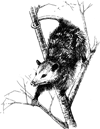Vertebrate Pest Conference: Proceedings

Vertebrate Pest Conference Proceedings: 16th (1994)
Date of this Version
2-17-1994
Document Type
Article
Abstract
In 1967, Howard provided a review of biological control of vertebrate pests. The term "biological control" was borrowed from the field of entomology, where it has been traditionally defined as "the reduction in number or density of pests through biological processes such as predation, pathogens, habitat modification, and fertility control." Current philosophy in wildlife damage management advocates "the reduction of damage to a tolerable level" rather than "the reduction of the number or density of vertebrate pests." Therefore we abdicate the term "biological control" and encourage the use of a new term, "biological management" of wildlife damage. Advances in science in the past 25 years have led to the testing and potential development of several biological methods for controlling wildlife damage and nuisance problems. We provide a nonexhaustive review of research in the following areas: secondary plant defense compounds, morphological plant defenses, predator odors, predation aversion compounds, pheromones, habitat modification, introduced and endemic predators, micro- and macroparasites, and fertility control through chemosterilants, genetic manipulation, and immunocontraception. No methods have been fully developed or are without problems. Several constraints associated with the development of biological management strategies are discussed.

